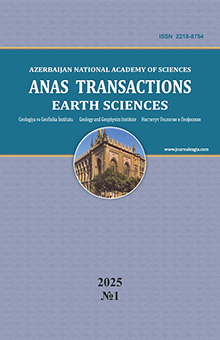Thermal tomography application for prospecting in the sedimentary basins
RAS Geological Institute, Moscow, Russia 7, Pyzhevsky lane, Moscow, 119017: mdkh1@yandex.ru
Summary
A thermal tomography technology has been developed, which is recommended to be included in the prospecting and exploration work complex in hydrocarbon fields. The practical value of the thermotomographic technique is to find temperature boundaries that control a particular process of generating or transforming a substance. It has been established that the oil and gas fields localization is controlled by the temperature rise in the sedimentary layer, which are associated with "thermal domes". Heat flow refraction occurs at the boundaries of the domes with country rocks due to the contrast in thermal conductivity of evaporites and terrigenous rocks between the domal zones. This is the main cause of heat flow variation in the lateral and vertical directions in the sedimentary basins. Close correlation between zones of elevated temperature in the sedimentary rocks and petroleum occurrences is confirmed by the results of 2D and 3D geothermal field modeling. 3D temperature models distribution in the Western Arctic area, in the Precaspian, Pripyat and North German depressions are presented. The previously noted relations of oil and gas fields to the deep faults in the studied basins create prerequisites for consideration of the geothermal field as a genetic factor controlling the tectonic features and petroleum resources of the sedimentary and salt-dome basins.
Keywords: temperature, heat flow, sedimentary basin, salt-dome, modeling
REFERENCES
Aizberg R.E., Garetsky R.G., Karabanov A.K. et al. Faults of the earth's crust on the territory of Belarus. Krasiko-Print. Minsk, 2007, с. 294-348 (in Russian).
Bayer U., Scheck M., Rabbel W. et al. An intergrated study of the NE German Basin. Tectonophysics, Vol. 314, No. 1-3, 1999, pp. 285-307.
Bushtar M.S., Lyvov M.S. Petroleum and gas geography and geology of the USSR and foreign countries. Nedra. Moscow, 1979, 368 p. (in Russian).
Clausen O.R. and Pedersen P.K. Late Triassic structural evolution of the southern margin of the Ringkobing Fyn High, Denmark. Mar. and Petrol. Geol., Vol. 16, No. 7, 1999, pp. 653-665.
Garetsky R.G., Pechernikov V.V., Aizberg R.E. and S. V. Klushin. Reflection of deep structure of the Pripyat Paleorift in thermobaric indexes of platform cover. Sov. Geol., No. 3, 1990, pp. 93-98.
Geology of Belarus. Institute of Geological Sciences of the National Academy of Sciences of Belarus. Minsk, 2001, 815 p. (in Russian).
Khutorskoi M.D. Geothermometry of the Central Asian Foldbelt. Peoples' Friendship University of Russia. Moscow, 1996, 285 p. (in Russian).
Khutorskoi M.D., Podgornykh L.V., Gramberg I.S., Leonov Yu.G. Thermal tomography of the West Arctic Basin. Geotectonics, Vol. 37, No. 3, 2003, pp. 245-261.
Khutorskoi M.D., Teveleva E.A., Tsybulya L.A., Urban G.I. Heat flow in salt_dome basins of Eurasia: A comparative study. Geotectonics, Vol. 44, No. 4, 2010, pp. 289-304.
Levashkevich V.G. Patterns of distribution of the geothermal field of the outskirts of the East European Platform (Barents Sea and Belarus-Baltic regions). Doctoral Dissertation in Geology and Mineralogy. Moscow State University, Moscow, 2005, 332 p.
Majorowicz J.A., Cermak V., Šafanda J. et al. Heat flow models across the Trans-European Suture Zone in the area of the POLONAISE-97 seismic experiment. Phys. Chem. Earth, Vol. 28, No. 9-11, 2003, pp. 375-391.
Mazur S., Scheck-Wenderoth M. Constraints on the tectonic evolution of the Central European Basin system revealed by seismic reflection profiles from Northern Germany. Netherlands J. Geosci. (Geol. Mijnb.), Vol. 84, No. 4, 2005, pp. 389-401.
Parkhomov M.D. Thermal regime of the Pripyat trough seismic and geothermal research in Belorussia. Nauka i Tekhnika. Minsk, 1985, pp. 124-130 (in Russian).
Suetnov V.V. and Nikul’shina E.A. Results of studying the parameters of a neutral layer in bottom sediments of the Southern Barents Sea. Geothermal studies on Seafloor. Nauka. Moscow, 1988, pp. 128-134 (in Russian).
Thibo H., Janik T., Omelchenko V.D. et al. Upper lithospheric seismic velocity structure across the Pripyat Trough and the Ukrainian Shield along the EUROBRIDGE’97 Profile. Tectonophysics. Vol. 371, No. 1, 2003, pp. 41-79.
Tsybulya L.A., Levashkevich V.G. Heat flow in the Pripyat Trough and caused of its heterogeneity. Journal of Geology, No. 4, 1990, pp. 20-38.
Ustritsky V.I., Khramov A.N. Geological history of the arctic in terms of plate tectonics. In: Seas of the Soviet Arctic. Nedra. Leningrad, 1984, pp. 253-265 (in Russian).
van Wees J.D., Stephenson R.A., Ziegler P.A. et al. On the origin of the Southern Permian Basin, Central Europe. Mar. and Petrol Geol., Vol. 17, 2000, pp. 43-59.
Verba M.L., Sharov N.V. The State of the art and main problems of the deep structure of the Barents Sea Region. Apatity. Vol. 1. Geol. Inst., Kola Sci. Center, Russian Acad. Sci., 1988, pp. 1-41 (in Russian).
Verzhbitsky E.V. Geothermal regime, seafloor tectonics, and hydrocarbon generation temperatures in the eastern part of the Barents Sea. Geotectonics, Vol. 36, No. 1, 2002, pp. 76-85.
Volozh Yu.A., Antipov M.P., Khortov A.V., Yurov Yu.G. Structure and tectonic setting of the pre jurassic complexes of sedimentary cover in Caspian Sector of the Northern Peritethys. Proceed. of the Society of Exploration Geophysicists (SEG). Moscow, 1998.
DOI: 10.33677/ggianas20230200101
